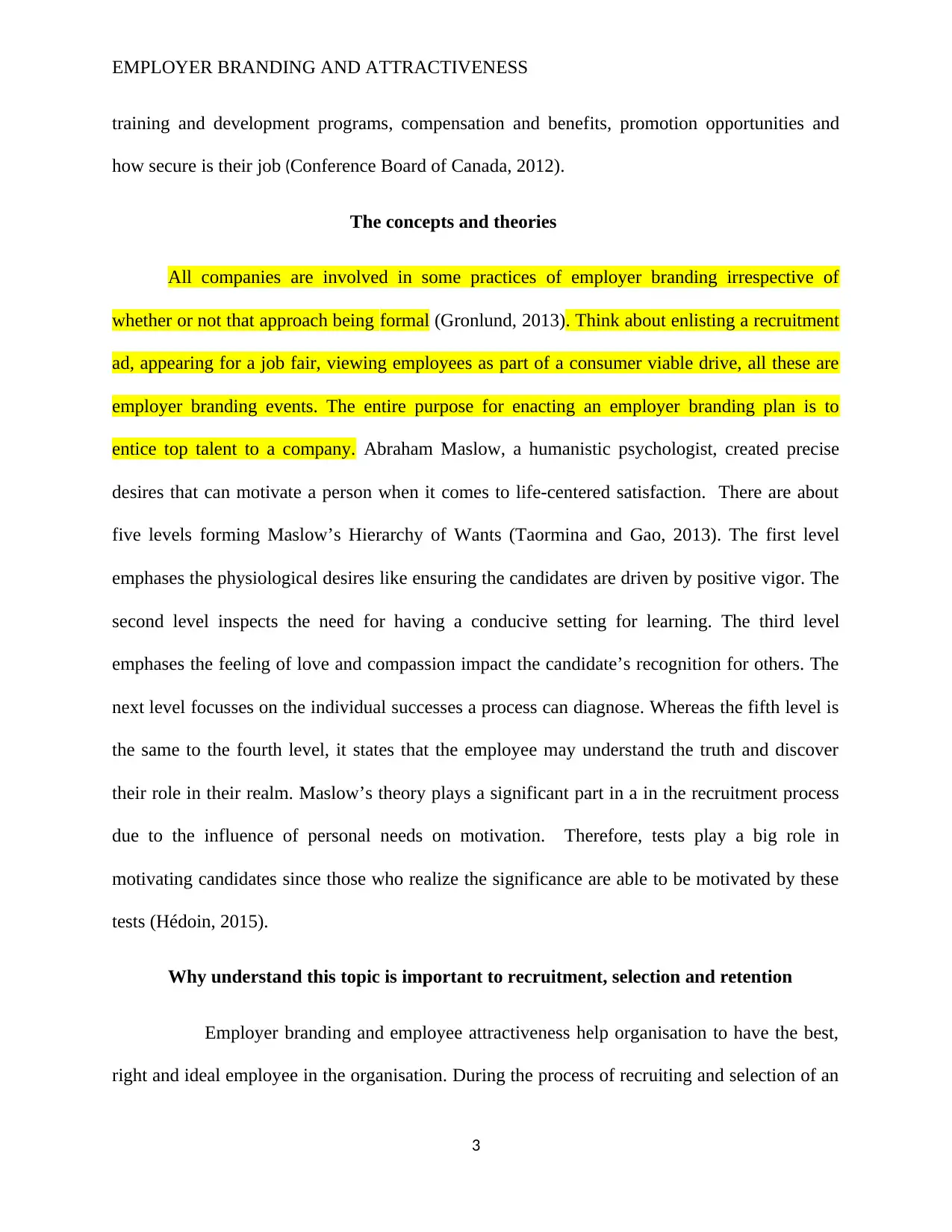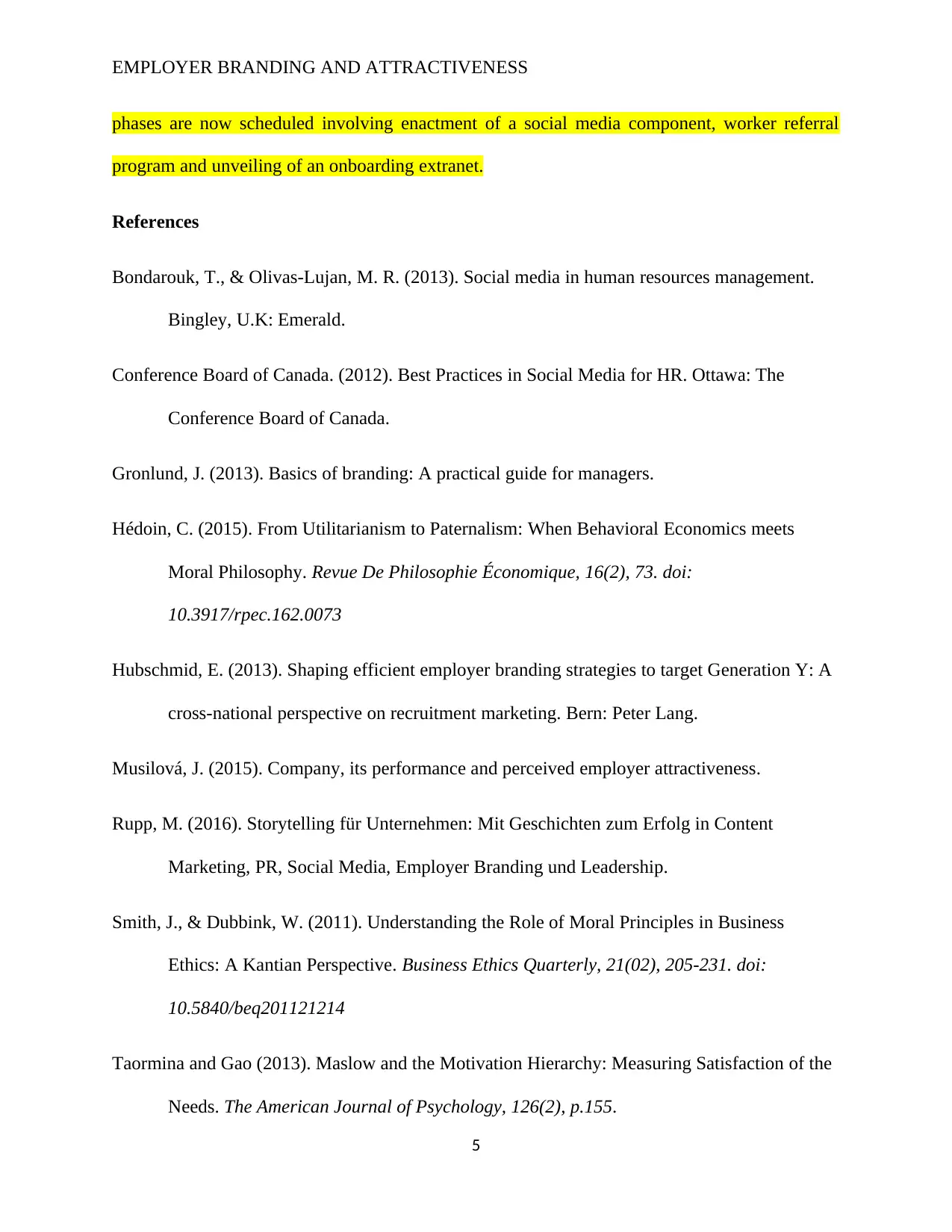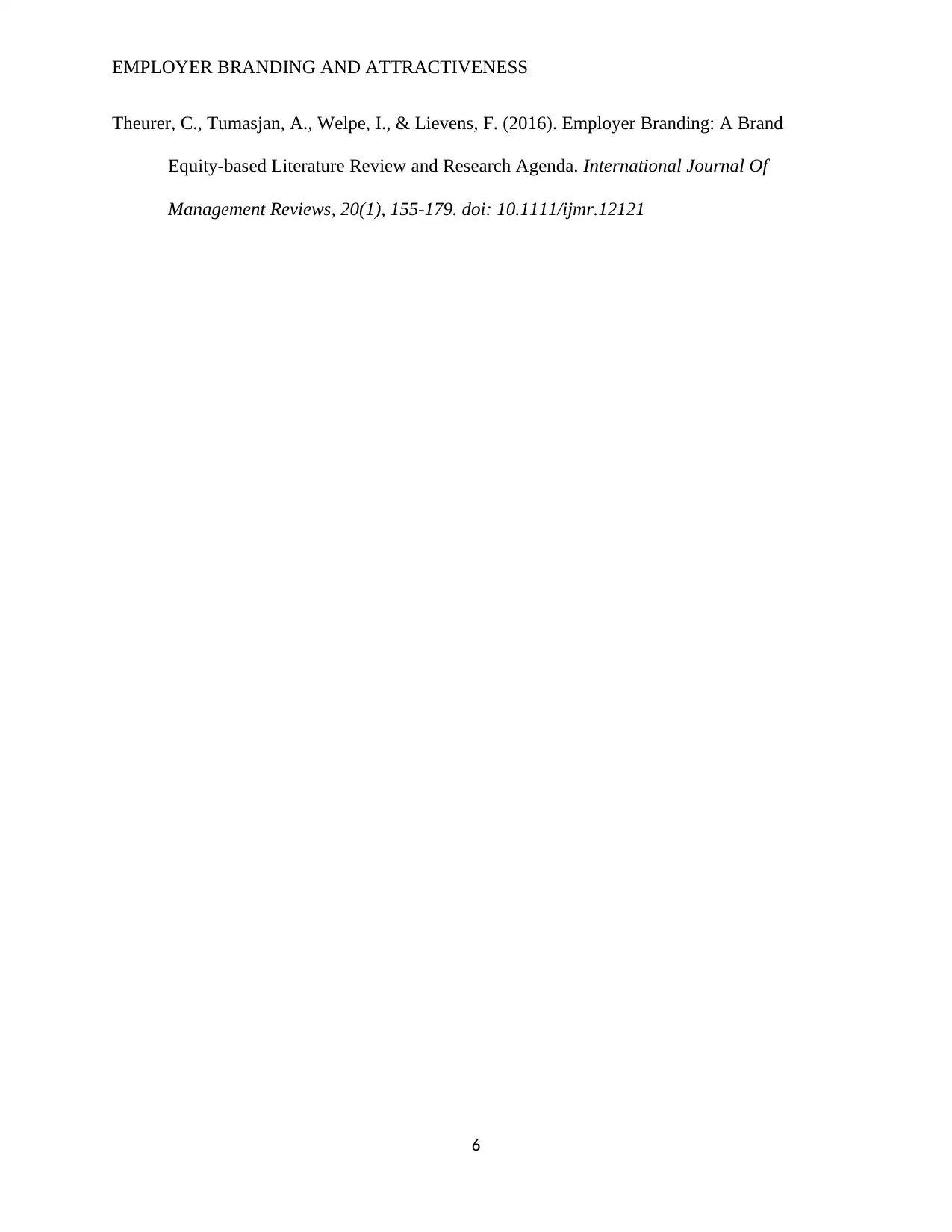Employer Branding and Attractiveness: Concepts and Theories
VerifiedAdded on 2023/06/07
|6
|1328
|383
Essay
AI Summary
This essay delves into the concept of employer branding, defining it as the process through which organizations cultivate a positive reputation to become the employer of choice. It emphasizes the importance of employer branding in attracting and retaining high-quality employees, highlighting its impact on recruitment and selection processes. The essay explores relevant concepts and theories, including Maslow's Hierarchy of Needs, to understand employee motivation and the factors influencing job choices. A workplace example, Coca-Cola's employer branding initiatives, is used to illustrate the practical application and organizational implications of these strategies. The essay concludes by underscoring the significance of employer branding in achieving organizational goals, fostering growth, and maintaining a competitive edge in the talent market.

Running Head: EMPLOYER BRANDING AND ATTRACTIVENESS
Employer Branding and Attractiveness
Student Name
Institution Affiliation
Date
Employer Branding and Attractiveness
Student Name
Institution Affiliation
Date
Paraphrase This Document
Need a fresh take? Get an instant paraphrase of this document with our AI Paraphraser

EMPLOYER BRANDING AND ATTRACTIVENESS
Introduction
Employer branding refers to the process in which an organisation builds a reputation as
the employer of choice through improving the value of employee positions and value rather than
its core activities and its products. Through the organisation branding, a company can recruit
employee with high-quality skills and thus can be able to retain those people who are regarded as
professionals researched (Theurer, Tumasjan, Welpe & Lievens, 2016). Through this strategy,
the organisation can attract ideal professions who are capable of coming up with new ideas thus
improving the company business plans.
Employer branding then is the method by which the employee identify their employer as
the employer of choice. For the organisation to achieve this, research should be carried out so as
to ensure that the employer's identity is well addressed and protected not only being based on top
talent but also for executive management appeal. Most of the potential employees evaluate the
information detail of their employers from other individuals. They then decide whether it is safe
to work in the organisation basing on what they have researched (Theurer, Tumasjan, Welpe &
Lievens, 2016). Before employees seek for job opportunities in any organisation, they evaluate
the employer's image and reputation. They analyse all the detail of that employer.
In their research, they may use question and answer form so as to find an opinion from
other employees so as to rate and value the attractiveness of the employer. They may also
consider the employer's views and contribution regarding objectives, physical and tangible
attributes that an employer may offer to his workers (Bondarouk & Olivas-Lujan, 2013,). Also,
the potential recruits will evaluate the employer brand name by the way he motivates employees
and other services he offers to his works. Examples of such services may be through offering
2
Introduction
Employer branding refers to the process in which an organisation builds a reputation as
the employer of choice through improving the value of employee positions and value rather than
its core activities and its products. Through the organisation branding, a company can recruit
employee with high-quality skills and thus can be able to retain those people who are regarded as
professionals researched (Theurer, Tumasjan, Welpe & Lievens, 2016). Through this strategy,
the organisation can attract ideal professions who are capable of coming up with new ideas thus
improving the company business plans.
Employer branding then is the method by which the employee identify their employer as
the employer of choice. For the organisation to achieve this, research should be carried out so as
to ensure that the employer's identity is well addressed and protected not only being based on top
talent but also for executive management appeal. Most of the potential employees evaluate the
information detail of their employers from other individuals. They then decide whether it is safe
to work in the organisation basing on what they have researched (Theurer, Tumasjan, Welpe &
Lievens, 2016). Before employees seek for job opportunities in any organisation, they evaluate
the employer's image and reputation. They analyse all the detail of that employer.
In their research, they may use question and answer form so as to find an opinion from
other employees so as to rate and value the attractiveness of the employer. They may also
consider the employer's views and contribution regarding objectives, physical and tangible
attributes that an employer may offer to his workers (Bondarouk & Olivas-Lujan, 2013,). Also,
the potential recruits will evaluate the employer brand name by the way he motivates employees
and other services he offers to his works. Examples of such services may be through offering
2

EMPLOYER BRANDING AND ATTRACTIVENESS
training and development programs, compensation and benefits, promotion opportunities and
how secure is their job (Conference Board of Canada, 2012).
The concepts and theories
All companies are involved in some practices of employer branding irrespective of
whether or not that approach being formal (Gronlund, 2013). Think about enlisting a recruitment
ad, appearing for a job fair, viewing employees as part of a consumer viable drive, all these are
employer branding events. The entire purpose for enacting an employer branding plan is to
entice top talent to a company. Abraham Maslow, a humanistic psychologist, created precise
desires that can motivate a person when it comes to life-centered satisfaction. There are about
five levels forming Maslow’s Hierarchy of Wants (Taormina and Gao, 2013). The first level
emphases the physiological desires like ensuring the candidates are driven by positive vigor. The
second level inspects the need for having a conducive setting for learning. The third level
emphases the feeling of love and compassion impact the candidate’s recognition for others. The
next level focusses on the individual successes a process can diagnose. Whereas the fifth level is
the same to the fourth level, it states that the employee may understand the truth and discover
their role in their realm. Maslow’s theory plays a significant part in a in the recruitment process
due to the influence of personal needs on motivation. Therefore, tests play a big role in
motivating candidates since those who realize the significance are able to be motivated by these
tests (Hédoin, 2015).
Why understand this topic is important to recruitment, selection and retention
Employer branding and employee attractiveness help organisation to have the best,
right and ideal employee in the organisation. During the process of recruiting and selection of an
3
training and development programs, compensation and benefits, promotion opportunities and
how secure is their job (Conference Board of Canada, 2012).
The concepts and theories
All companies are involved in some practices of employer branding irrespective of
whether or not that approach being formal (Gronlund, 2013). Think about enlisting a recruitment
ad, appearing for a job fair, viewing employees as part of a consumer viable drive, all these are
employer branding events. The entire purpose for enacting an employer branding plan is to
entice top talent to a company. Abraham Maslow, a humanistic psychologist, created precise
desires that can motivate a person when it comes to life-centered satisfaction. There are about
five levels forming Maslow’s Hierarchy of Wants (Taormina and Gao, 2013). The first level
emphases the physiological desires like ensuring the candidates are driven by positive vigor. The
second level inspects the need for having a conducive setting for learning. The third level
emphases the feeling of love and compassion impact the candidate’s recognition for others. The
next level focusses on the individual successes a process can diagnose. Whereas the fifth level is
the same to the fourth level, it states that the employee may understand the truth and discover
their role in their realm. Maslow’s theory plays a significant part in a in the recruitment process
due to the influence of personal needs on motivation. Therefore, tests play a big role in
motivating candidates since those who realize the significance are able to be motivated by these
tests (Hédoin, 2015).
Why understand this topic is important to recruitment, selection and retention
Employer branding and employee attractiveness help organisation to have the best,
right and ideal employee in the organisation. During the process of recruiting and selection of an
3
⊘ This is a preview!⊘
Do you want full access?
Subscribe today to unlock all pages.

Trusted by 1+ million students worldwide

EMPLOYER BRANDING AND ATTRACTIVENESS
employee, the employer brand can be recognised by the number of applicants who comes for the
interviews, the qualification they got and their willingness to work with the organisation. Thus
enabling the company to have high output, thus high productivity levels (Hubschmid, E. 2013). It
is important for an organisation to consider the qualification of an employee by considering the
level of skills, (Musilová, J. 2015). Through employer branding and attractiveness help to
maintain and retain the organisation can retain its professionals and active employees who have
potential to give entrepreneurial ideas to the organisation. These ideas help an organisation to
experience growth and development.
Workplace example
Coca-Cola hires about 1,600 Company associates who work with European bottler workers who
are over 60,000. Coca-Cola recently went on board on an employer brand refresh reinforced by
SAS managed by the Talent Manager of Coca-Cola Europe, Stephen Mulvenna, the company
goals of revitalizing its employer brand include recruiting and retaining high prospective talent in
a reliable and further practical and straight way in Europe (Rupp. M, 2016). Reduction of
recruitment spend as well as getting off from every nation having its own human resource
location are also objectives of this program.
The implication to organization
This program plays a significant role in Coca-Cola’s employer brand. Among the places to
realize the impact is Coca-Cola Europe’s employment website. In the fresh branding, the core
part of the site is the stories of Coca-Cola employees from around Europe (Smith, J., & Dubbink,
W, 2011). This program is considered an achievement in Coca-Cola Europe and some thrilling
4
employee, the employer brand can be recognised by the number of applicants who comes for the
interviews, the qualification they got and their willingness to work with the organisation. Thus
enabling the company to have high output, thus high productivity levels (Hubschmid, E. 2013). It
is important for an organisation to consider the qualification of an employee by considering the
level of skills, (Musilová, J. 2015). Through employer branding and attractiveness help to
maintain and retain the organisation can retain its professionals and active employees who have
potential to give entrepreneurial ideas to the organisation. These ideas help an organisation to
experience growth and development.
Workplace example
Coca-Cola hires about 1,600 Company associates who work with European bottler workers who
are over 60,000. Coca-Cola recently went on board on an employer brand refresh reinforced by
SAS managed by the Talent Manager of Coca-Cola Europe, Stephen Mulvenna, the company
goals of revitalizing its employer brand include recruiting and retaining high prospective talent in
a reliable and further practical and straight way in Europe (Rupp. M, 2016). Reduction of
recruitment spend as well as getting off from every nation having its own human resource
location are also objectives of this program.
The implication to organization
This program plays a significant role in Coca-Cola’s employer brand. Among the places to
realize the impact is Coca-Cola Europe’s employment website. In the fresh branding, the core
part of the site is the stories of Coca-Cola employees from around Europe (Smith, J., & Dubbink,
W, 2011). This program is considered an achievement in Coca-Cola Europe and some thrilling
4
Paraphrase This Document
Need a fresh take? Get an instant paraphrase of this document with our AI Paraphraser

EMPLOYER BRANDING AND ATTRACTIVENESS
phases are now scheduled involving enactment of a social media component, worker referral
program and unveiling of an onboarding extranet.
References
Bondarouk, T., & Olivas-Lujan, M. R. (2013). Social media in human resources management.
Bingley, U.K: Emerald.
Conference Board of Canada. (2012). Best Practices in Social Media for HR. Ottawa: The
Conference Board of Canada.
Gronlund, J. (2013). Basics of branding: A practical guide for managers.
Hédoin, C. (2015). From Utilitarianism to Paternalism: When Behavioral Economics meets
Moral Philosophy. Revue De Philosophie Économique, 16(2), 73. doi:
10.3917/rpec.162.0073
Hubschmid, E. (2013). Shaping efficient employer branding strategies to target Generation Y: A
cross-national perspective on recruitment marketing. Bern: Peter Lang.
Musilová, J. (2015). Company, its performance and perceived employer attractiveness.
Rupp, M. (2016). Storytelling für Unternehmen: Mit Geschichten zum Erfolg in Content
Marketing, PR, Social Media, Employer Branding und Leadership.
Smith, J., & Dubbink, W. (2011). Understanding the Role of Moral Principles in Business
Ethics: A Kantian Perspective. Business Ethics Quarterly, 21(02), 205-231. doi:
10.5840/beq201121214
Taormina and Gao (2013). Maslow and the Motivation Hierarchy: Measuring Satisfaction of the
Needs. The American Journal of Psychology, 126(2), p.155.
5
phases are now scheduled involving enactment of a social media component, worker referral
program and unveiling of an onboarding extranet.
References
Bondarouk, T., & Olivas-Lujan, M. R. (2013). Social media in human resources management.
Bingley, U.K: Emerald.
Conference Board of Canada. (2012). Best Practices in Social Media for HR. Ottawa: The
Conference Board of Canada.
Gronlund, J. (2013). Basics of branding: A practical guide for managers.
Hédoin, C. (2015). From Utilitarianism to Paternalism: When Behavioral Economics meets
Moral Philosophy. Revue De Philosophie Économique, 16(2), 73. doi:
10.3917/rpec.162.0073
Hubschmid, E. (2013). Shaping efficient employer branding strategies to target Generation Y: A
cross-national perspective on recruitment marketing. Bern: Peter Lang.
Musilová, J. (2015). Company, its performance and perceived employer attractiveness.
Rupp, M. (2016). Storytelling für Unternehmen: Mit Geschichten zum Erfolg in Content
Marketing, PR, Social Media, Employer Branding und Leadership.
Smith, J., & Dubbink, W. (2011). Understanding the Role of Moral Principles in Business
Ethics: A Kantian Perspective. Business Ethics Quarterly, 21(02), 205-231. doi:
10.5840/beq201121214
Taormina and Gao (2013). Maslow and the Motivation Hierarchy: Measuring Satisfaction of the
Needs. The American Journal of Psychology, 126(2), p.155.
5

EMPLOYER BRANDING AND ATTRACTIVENESS
Theurer, C., Tumasjan, A., Welpe, I., & Lievens, F. (2016). Employer Branding: A Brand
Equity-based Literature Review and Research Agenda. International Journal Of
Management Reviews, 20(1), 155-179. doi: 10.1111/ijmr.12121
6
Theurer, C., Tumasjan, A., Welpe, I., & Lievens, F. (2016). Employer Branding: A Brand
Equity-based Literature Review and Research Agenda. International Journal Of
Management Reviews, 20(1), 155-179. doi: 10.1111/ijmr.12121
6
⊘ This is a preview!⊘
Do you want full access?
Subscribe today to unlock all pages.

Trusted by 1+ million students worldwide
1 out of 6
Related Documents
Your All-in-One AI-Powered Toolkit for Academic Success.
+13062052269
info@desklib.com
Available 24*7 on WhatsApp / Email
![[object Object]](/_next/static/media/star-bottom.7253800d.svg)
Unlock your academic potential
Copyright © 2020–2025 A2Z Services. All Rights Reserved. Developed and managed by ZUCOL.





